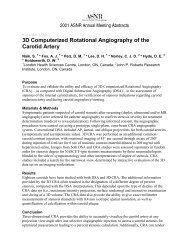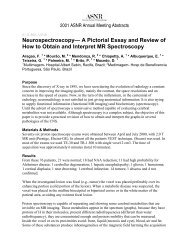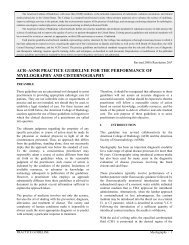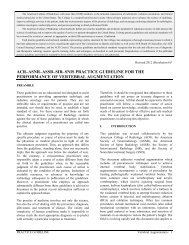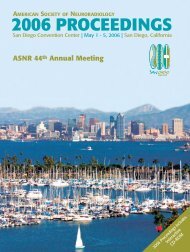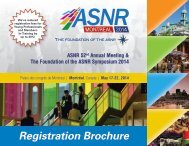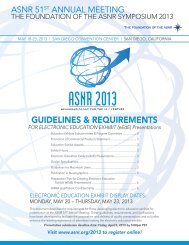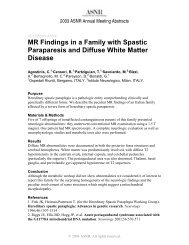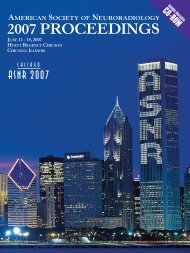Diagnostic Evaluation of Temporal Bone Trauma ... - For Members
Diagnostic Evaluation of Temporal Bone Trauma ... - For Members
Diagnostic Evaluation of Temporal Bone Trauma ... - For Members
You also want an ePaper? Increase the reach of your titles
YUMPU automatically turns print PDFs into web optimized ePapers that Google loves.
2003 ASNR Annual Meeting Abstracts<br />
03-CAE-996-ASNR<br />
<strong>Diagnostic</strong> <strong>Evaluation</strong> <strong>of</strong> <strong>Temporal</strong> <strong>Bone</strong><br />
<strong>Trauma</strong>: Review <strong>of</strong> Fracture<br />
Classification, Assessment <strong>of</strong><br />
Complication, and Clinical Management<br />
Author(s):<br />
Hartman, M. J.·Gentry, L. R.<br />
University <strong>of</strong> Wisconsin<br />
Madison, WI.<br />
Purpose<br />
To provide a comprehensive training module for radiology residents and neuroradiology<br />
fellows for diagnostic evaluation and clinical management <strong>of</strong> patients with temporal bone<br />
trauma. The main focus <strong>of</strong> this computer-aided exhibit will be to review the current<br />
classification systems, demonstrate the common complications <strong>of</strong> temporal bone trauma<br />
(facial nerve palsy, conductive hearing loss, vascular injuries, sensorineural hearing loss,<br />
CSF leaks, vestibular symptoms), and to review important clinical management decisions<br />
in these patients.<br />
Materials & Methods<br />
<strong>Diagnostic</strong> images and medical records <strong>of</strong> 100 consecutive patients with temporal bone<br />
fractures and were reviewed retrospectively. The clinical information was reviewed<br />
specifically for evidence <strong>of</strong> common complications related to temporal bone fracture.<br />
Results<br />
The fractures were analyzed by the traditional classification system [transverse, (n = 5)<br />
longitudinal (n = 74), complex (n = 20), other (n = 1) as well as a more recently proposed<br />
classification system (labyrinthine (n = 25), extra-labyrinthine (n = 75)]. Bilateral<br />
fractures were present in 19% <strong>of</strong> patients. The frequencies <strong>of</strong> different types <strong>of</strong><br />
complications were assessed for each <strong>of</strong> these classification systems. The newer<br />
classification system allowed more uniformity in the classification <strong>of</strong> the fractures and<br />
more consistently predicted associated clinical complications when compared with the<br />
traditional classification system. Sensorineural hearing loss, ossicular injuries, facial<br />
nerve palsy, vascular injuries, and CSF leaks were the most common clinical<br />
complications identified.<br />
Conclusion<br />
This hypertext-driven computer-aided exhibit attempts to train radiology resident to<br />
systematically evaluate patients with fractures <strong>of</strong> the temporal bone. The goal is to teach<br />
residents to accurately classify temporal bone fractures and to properly evaluate the<br />
© 2003 ASNR. All rights reserved.
2003 ASNR Annual Meeting Abstracts<br />
patient for the most common clinical complications. This training module reviews the<br />
merits <strong>of</strong> traditional and newer classification systems for temporal bone trauma. The<br />
module systematically reviews the common clinical complications that occur with these<br />
fractures and depicts the typical diagnostic appearance <strong>of</strong> these complications on<br />
multimodality imaging. <strong>Diagnostic</strong> protocols for assessment <strong>of</strong> facial nerve palsy, hearing<br />
loss, CSF leaks, and vascular injuries are notably emphasized. A pre and posttest<br />
assessment allows residents to monitor their learning progress.<br />
© 2003 ASNR. All rights reserved.



